
In bridge-book publication, some years are more fertile than others. This year, for example, we have a plethora of great works by the world’s best bridge authors. Thus, the competition for this year’s Master Point Press Book of the Year award will be fierce: three of the authors (Mark Horton, Roy Hughes and Julian Pottage) of the seven hortlisted books (the most we’ve ever had shortlisted) have previously won the award. In other years, at least two of the books that didn’t make this year’s shortlist would undoubtedly have done so. Here are the candidates…
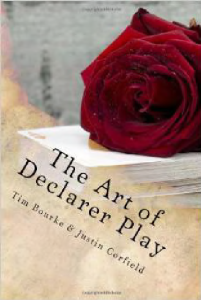 The Art of Declarer Play – Tim Bourke & Justin Corfield. The lead author is of course familiar to IBPA members as the Column Service guru of the past 11 years. Additionally, Bourke writes problem columns for most big Australian bridge tournament Daily Bulletins, such as those for the Canberra Festival and the Gold Coast Congress. There’s no doubting that he has an eye for a problem deal and has a wealth of material in his files. The Art of Declarer Play is about how to handle non-straightforward contracts. This book is for players who already have a good grasp of declarer-play technique, the blocking and unblocking plays, the eliminations and the squeezes. Bourke and Corfield reveal what goes on inside the mind of an expert, explaining how to anticipate the likely distribution, how to use logic and visualization, how to listen to the cards, and many other ways to make ‘impossible’ contracts.
The Art of Declarer Play – Tim Bourke & Justin Corfield. The lead author is of course familiar to IBPA members as the Column Service guru of the past 11 years. Additionally, Bourke writes problem columns for most big Australian bridge tournament Daily Bulletins, such as those for the Canberra Festival and the Gold Coast Congress. There’s no doubting that he has an eye for a problem deal and has a wealth of material in his files. The Art of Declarer Play is about how to handle non-straightforward contracts. This book is for players who already have a good grasp of declarer-play technique, the blocking and unblocking plays, the eliminations and the squeezes. Bourke and Corfield reveal what goes on inside the mind of an expert, explaining how to anticipate the likely distribution, how to use logic and visualization, how to listen to the cards, and many other ways to make ‘impossible’ contracts.
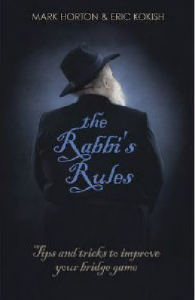 The Rabbi’s Rules – Mark Horton & Eric Kokish. The rabbi of the book’s title is Leonard Helman of Santa Fe, New Mexico, a great friend of bridge, who died last year. The Rabbi’s Rule, not attributed to Helman, was due to kibitzer Milton Shattner of New York City, who earned his nickname “The Rabbi” by his pontificating as a kibitzer. Among other gems was his, “If the king is singleton, play the ace.” Horton formed a trans-Atlantic partnership with Rabbi Helman (a genuine rabbi) for many years, and their adventures at and away from the table form the basis for the book. Horton was assisted by one of the best bridge writers never to have authored his own book (not counting the World Championship books, which he and edited and wrote portions of for many years), Eric Kokish. The book is subtitled Tips and Tricks to Improve Your Bridge Game, so it’s not simply a book of bridge stories. Some of the tips are more serious than others: for example, the Helman Variation states that suits break 3-3 in the afternoon and 4-2 during the evening.
The Rabbi’s Rules – Mark Horton & Eric Kokish. The rabbi of the book’s title is Leonard Helman of Santa Fe, New Mexico, a great friend of bridge, who died last year. The Rabbi’s Rule, not attributed to Helman, was due to kibitzer Milton Shattner of New York City, who earned his nickname “The Rabbi” by his pontificating as a kibitzer. Among other gems was his, “If the king is singleton, play the ace.” Horton formed a trans-Atlantic partnership with Rabbi Helman (a genuine rabbi) for many years, and their adventures at and away from the table form the basis for the book. Horton was assisted by one of the best bridge writers never to have authored his own book (not counting the World Championship books, which he and edited and wrote portions of for many years), Eric Kokish. The book is subtitled Tips and Tricks to Improve Your Bridge Game, so it’s not simply a book of bridge stories. Some of the tips are more serious than others: for example, the Helman Variation states that suits break 3-3 in the afternoon and 4-2 during the evening.
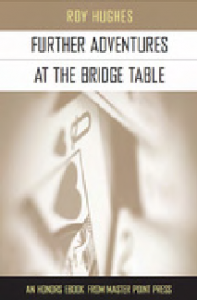 Further Adventures at the Bridge Table – Roy Hughes. This is Hughes’ fifth bridge book. All five have been shortlisted for MPP Book of the Year and two have won; a third was a close runner-up. He’s the closest thing we have to a Mr. Automatic in producing brilliant books. This book takes the reader further along the path traversed by Card by Card. Hughes presents intriguing problems in declarer play and defence and follows them with comprehensive analysis, given with a light touch and the occasional entertaining diversion. Sami Kehela says, “I think it is fair to say there will be something here for everyone interested in card play, for those who wish to improve as well as those who wish only to enjoy.”
Further Adventures at the Bridge Table – Roy Hughes. This is Hughes’ fifth bridge book. All five have been shortlisted for MPP Book of the Year and two have won; a third was a close runner-up. He’s the closest thing we have to a Mr. Automatic in producing brilliant books. This book takes the reader further along the path traversed by Card by Card. Hughes presents intriguing problems in declarer play and defence and follows them with comprehensive analysis, given with a light touch and the occasional entertaining diversion. Sami Kehela says, “I think it is fair to say there will be something here for everyone interested in card play, for those who wish to improve as well as those who wish only to enjoy.”
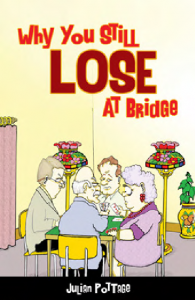 Why You Still Lose at Bridge – Julian Pottage. Pottage is another current writer who’s produced an impressive number of terrific bridge books and has won the MPP Book of the Year award twice. A few years ago, he authored a book called Back Through the Pack, a sequel to the 1957 classic by Darvas and Hart – now, he’s done it again with a sequel to S. J. (Skid) Simon’s 1940 masterpiece, Why You Lose at Bridge. It takes nerve and confidence in one’s abilities to attempt this feat and Pottage’s results justify the risks. Simon’s original work dispensed advice to the improving player through archetypical bridge characters such as Futile Willie, the Unlucky Expert, and Mrs. Guggenheim. In this follow-up book, Pottage uses the same approach to discuss common failings of modern club players such as mis-describing your shape, overvaluing your hand, bidding the wrong slam, playing a flawed system, giving the wrong signal, making losing leads, and many more.
Why You Still Lose at Bridge – Julian Pottage. Pottage is another current writer who’s produced an impressive number of terrific bridge books and has won the MPP Book of the Year award twice. A few years ago, he authored a book called Back Through the Pack, a sequel to the 1957 classic by Darvas and Hart – now, he’s done it again with a sequel to S. J. (Skid) Simon’s 1940 masterpiece, Why You Lose at Bridge. It takes nerve and confidence in one’s abilities to attempt this feat and Pottage’s results justify the risks. Simon’s original work dispensed advice to the improving player through archetypical bridge characters such as Futile Willie, the Unlucky Expert, and Mrs. Guggenheim. In this follow-up book, Pottage uses the same approach to discuss common failings of modern club players such as mis-describing your shape, overvaluing your hand, bidding the wrong slam, playing a flawed system, giving the wrong signal, making losing leads, and many more.
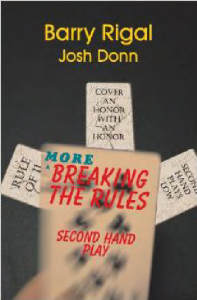 More Breaking the Rules: Second Hand Play – Barry Rigal & Josh Donn. Lead author Barry Rigal is a familiar figure all over the bridge world as a Daily Bulletin editor, VuGraph commentator, player and writer. He has championed ‘breaking the rules’ with the first book in this series and a number of articles on the topic in the U.K.’s Bridge Magazine. Rigal’s collaborator is an American World Junior Champion. The current work goes beyond the basic rules that, in a vacuum, provide helpful advice to players. It is for advanced intermediate players and deals exclusively with second hand play, both by declarer and the defenders.
More Breaking the Rules: Second Hand Play – Barry Rigal & Josh Donn. Lead author Barry Rigal is a familiar figure all over the bridge world as a Daily Bulletin editor, VuGraph commentator, player and writer. He has championed ‘breaking the rules’ with the first book in this series and a number of articles on the topic in the U.K.’s Bridge Magazine. Rigal’s collaborator is an American World Junior Champion. The current work goes beyond the basic rules that, in a vacuum, provide helpful advice to players. It is for advanced intermediate players and deals exclusively with second hand play, both by declarer and the defenders.
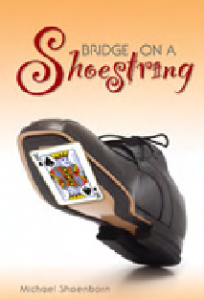 Bridge on a Shoestring – Michael Schoenborn. Thirty years ago, Michael Schoenborn wrote a series of sparkling articles for The Kibitzer, Ontario’s bridge magazine. When asked to write a book on his theme of extraordinary and amusing characters and occurrences at the local bridge club, he promised to do so. A man of his word, here is the promised book, three decades later, a thinly-veiled, fictionalized account of ‘The Shoe’s’ own experiences as a young player in Toronto in the 1960’s and 70’s. After a Bermuda Bowl appearance in 1987, The Shoe entered semi-retirement to focus on his young family and burgeoning legal career, emerging again in the new millennium as a formidable presence on the Canadian Senior bridge scene.
Bridge on a Shoestring – Michael Schoenborn. Thirty years ago, Michael Schoenborn wrote a series of sparkling articles for The Kibitzer, Ontario’s bridge magazine. When asked to write a book on his theme of extraordinary and amusing characters and occurrences at the local bridge club, he promised to do so. A man of his word, here is the promised book, three decades later, a thinly-veiled, fictionalized account of ‘The Shoe’s’ own experiences as a young player in Toronto in the 1960’s and 70’s. After a Bermuda Bowl appearance in 1987, The Shoe entered semi-retirement to focus on his young family and burgeoning legal career, emerging again in the new millennium as a formidable presence on the Canadian Senior bridge scene.
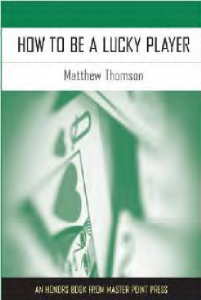 How to Be a Lucky Player – Matthew Thomson. Matthew Thomson is one of Australia’s top international players. It is Thomson’s premise that the best players are lucky players and that this is no coincidence. You can become a ‘better’ player by improving your bidding system with your partner and by improving your declarer play and defensive technique. However, this will not make you a lucky player. In this book, illustrated with deals from actual play, Thomson demonstrates how to become a lucky player. Lucky players evaluate their trick-winning potential, recognise and grab their opportunities and maximize their scores over all the likely distributions of the cards. They know how to evaluate the potential of a bridge hand, and then how to apply and execute that evaluation to the bidding and play.
How to Be a Lucky Player – Matthew Thomson. Matthew Thomson is one of Australia’s top international players. It is Thomson’s premise that the best players are lucky players and that this is no coincidence. You can become a ‘better’ player by improving your bidding system with your partner and by improving your declarer play and defensive technique. However, this will not make you a lucky player. In this book, illustrated with deals from actual play, Thomson demonstrates how to become a lucky player. Lucky players evaluate their trick-winning potential, recognise and grab their opportunities and maximize their scores over all the likely distributions of the cards. They know how to evaluate the potential of a bridge hand, and then how to apply and execute that evaluation to the bidding and play.
***
IBPA (International Bridge Press Association) Bulletin No. 592 May 2014